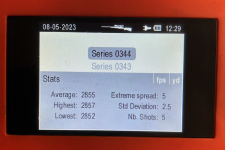Every time I shot 10x 5-shots groups, there would be about 3 groups with ES over 30. sometimes they go into the 40s and 50s range.
I have tried Lee collet die, Redding full length sizing die, Forster Neck bushing + Full length size + mandrels (2/1k and 3/1k tension), Imperial Dry Wax. Did not see any difference.
The best 10 groups are typically with virgin brass where my average ES is 20 and SD is 10. but I still get 1-2 groups with ES of about 30.
My steps:
- De-prime
- Wet tumble
- Dry brass in oven for 1h at 200F
- Lube case and Neck bushing + length sizing
- Mandrel
- Dispense powder then seat bullet
6.5 CM
Berger 140 Hybrid and Berger 144 Hybrid
Alpha SRP
Relode 16 43gr
CCI 450, BR4
What else should I do?
Thanks for any help.
I have tried Lee collet die, Redding full length sizing die, Forster Neck bushing + Full length size + mandrels (2/1k and 3/1k tension), Imperial Dry Wax. Did not see any difference.
The best 10 groups are typically with virgin brass where my average ES is 20 and SD is 10. but I still get 1-2 groups with ES of about 30.
My steps:
- De-prime
- Wet tumble
- Dry brass in oven for 1h at 200F
- Lube case and Neck bushing + length sizing
- Mandrel
- Dispense powder then seat bullet
6.5 CM
Berger 140 Hybrid and Berger 144 Hybrid
Alpha SRP
Relode 16 43gr
CCI 450, BR4
What else should I do?
Thanks for any help.



